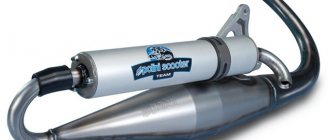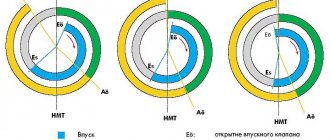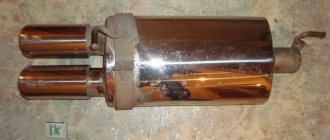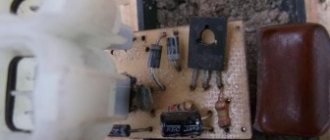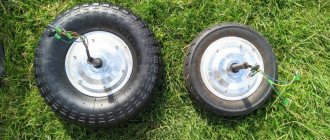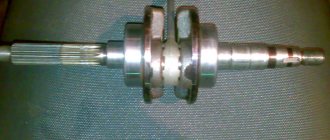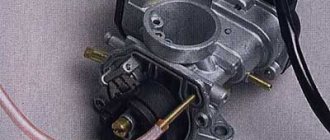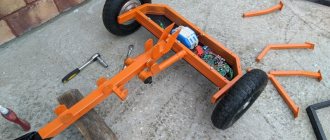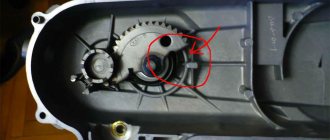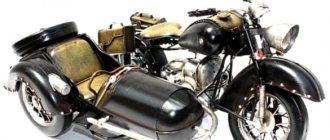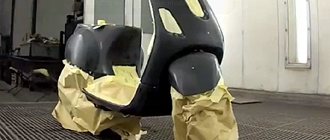DIY saxophone muffler for scooter
Even with minimal tuning of the scooter, you need to think about installing a resonant exhaust .
The operating principle and review of saxophones, as such mufflers are popularly called, will be given in another article. A resonant saxophone muffler is not a cheap thing and not everyone can afford it. Accordingly, scooterists have a desire to save money and make such an exhaust pipe on their own. In this article you will learn how to make a primitive homemade saxophone using the example of a Yamaha Jog scooter. Why primitive? Because with this method we will not carry out calculations of the resonator (this requires a special program), but will simply use a drawing of a saxophone muffler.
Why does a chainsaw make noise and why do you need a muffler?
A person can easily tolerate noise of 40 dB. The operation of a chainsaw creates noise pollution of sometimes 120 dB. Its two-stroke, single-cylinder engine produces more annoying sound vibrations than a four-cylinder car engine.
A chainsaw muffler reduces noise levels thanks to:
In addition, it extinguishes sparks, reduces the temperature and speed of the exhaust gas mixture, and diverts it to the side. In this case, there should be a minimum of obstacles to the exit of gases and the entry of air.
How to Make a Yamaha Jog Saxophone Silencer
So let's get started. To make a saxophone, we need metal approximately 1.2 mm thick. It must be cut according to the dimensions indicated on the drawing (You can adjust these dimensions closer to your parameters). In order to accurately bend the metal, we grind a wooden blank to size (we get a kind of wooden muffler) and then bend the steel according to this shape. After carefully adjusting the workpiece, we weld the joints using semi-automatic welding. We clean the part using any available means.
We also bend the muffler and muffler pipe. On one side we weld it completely, and on the other side with rivets (to replace the filler, here it is glass wool). After welding, we check all elements for leaks - there should be no gaps, of course.
We sand all the parts and paint. In this case, the muffler is painted with powder paint, and everything else is painted with simple acrylic paint.
The fastenings on the muffler are made of stainless steel.
And here is the result of our painstaking work - a copy of the Tecnigas saxophone . Not bad, right?
A saxophone on a scooter looks even better .
After installing such a muffler, you may need to adjust the scooter's carburetor, adjust the transmission as a whole, and the engine in general.
Source
Two stroke and four stroke scooter
A scooter, as you know, can be with a two-stroke or a four-stroke engine. The operating principle of the entire exhaust system differs radically among analogues.
The muffler on a four-stroke scooter removes gases in a relatively shorter time, doing this with minimal noise. In addition, tuning the muffler in this case will be quite simple. On the other hand, in both cases, when carrying out tuning, it will be necessary to change the pipes.
Types of mufflers for scooters
For the muffler of a two-stroke scooter, selecting components that make it possible to carry out tuning will be much more difficult. The standard muffler itself for such scooters is more difficult to manufacture and configure.
The exhaust system of a two-stroke scooter works as follows. During the process of cleaning exhaust gases, part of the power is returned to the engine. This happens at certain speeds and if you manage to implement this whole process by tuning, the scooter will be unrecognizable.
You can install a high-quality and correctly tuned resonator on a two-stroke scooter. This will give a noticeable increase in dynamics up to a quarter. But in this case, it will be important to carry out professional settings of the entire power system.
Why do you need a tuning muffler?
Tuning companies produce a huge number of wonderful mufflers for the most popular European, Japanese, Taiwanese and Korean scooters. You can always choose a specific model for any budget. The price in this case depends on the complexity of the design, quality, and popularity of the scooter model for which it is designed. However, it's worth it.
After installing a high-quality and correctly configured resonator on a two-stroke scooter, you can expect an increase in power of up to 25% only after professional adjustments to the power system. This is a considerable figure, considering that in tuning, for example, for racing, the struggle is for every millisecond during the competition. For everyday life this is not so important, and the difference in power increase between 20 and 25% is difficult to notice, but experienced scooter riders will not remain indifferent after installing a branded saxophone.
Why do you need quality mufflers?
As you know, a certain amount of fuel combustion products accumulates in the cylinders of a moped engine. They must be thrown out and in this case it is the muffler that is responsible for this. In other words, this unit seems to smooth out the pulsations that are inevitable when combustion products are released at high speed.
The very design of the muffler, used not only on scooters and mopeds, but also on motorcycles and cars, implies a special exhaust system, which can be different, depending on what result the vehicle owner wants to achieve. For example, if the desire to improve the gas exhaust system is related to increasing the power of the scooter, a special type of muffler is required - a direct-flow muffler.
Direct flow type muffler
Direct-flow muffler device for moped
Installing this type of muffler will not only increase dynamic power, but will also significantly increase the noise emitted when gases escape. On the one hand, this is good, because this way you can attract the attention of other drivers, thereby increasing passive safety. As you know, drivers of large cars often complain that they do not notice motorcyclists, and mopeds and scooters even more so.
Making such a muffler from scratch or using a method that involves tuning is not difficult, but many technical aspects need to be studied.
Features of a direct-flow muffler
The features of direct flow are as follows: exhaust gases are ejected outside the engine immediately, the cylinders of the power unit have time to fill with the fuel mixture in the optimal amount.
I would like to remind all readers that at the moments of intake and exhaust, engine valves tend to open and close. Between these stages, a vacuum occurs, which allows the cylinders to be cleared of exhaust gases. As a result, free space is freed up, where the fuel mixture is supplied. It is easy to guess that the faster the cylinders are released from exhaustion, the faster they will be filled.
Thus, if you can ensure a faster exit of gases from the system, the performance and, as a result, the power of the scooter or moped will increase.
The principle of operation of the internal combustion engine
The working cycle of a two-stroke engine consists of intake and exhaust occurring per revolution of the crankshaft, while a 4-stroke engine has the following cycles - intake, compression, power stroke, exhaust. And they leak within two revolutions of the flywheel. In a 4-stroke engine, intake and exhaust are carried out in the form of different processes; in a two-stroke engine they are combined with compression of the fuel mixture and expansion of the working gases. Operating principle of a two-stroke engine:
A two-stroke diesel engine works on the same principle, only it does not have a spark plug, and the fuel is ignited by compression. Therefore, the compression ratio in diesel engines is much higher than gasoline engines.
Cleaning the muffler
The cleanliness of the muffler affects the power of the moped
Before you start changing anything in the exhaust system, I would like to give one piece of advice. The power of the scooter is directly affected by the cleanliness of the muffler. If it were possible to see the exhaust in a cross-section of the muffler, the owner of the scooter would be very surprised. After a certain mileage, the scooter's dynamics decrease, and owners begin to look for the reasons for this, finding them in a complete rework of the standard muffler or its replacement.
The reason for the loss of power, meanwhile, may be hidden in the condition of the engine itself. This will help determine the specialist you should contact before tuning. But the most common cause of loss of dynamics is soot that clogs the muffler. In this case, it is recommended to carry out cleaning in three ways.
First method: mechanical
It involves cleaning the muffler section (it is done with a grinder). The inside of the muffler is cleaned of soot using a wire or cable. The section in the section is closed by welding.
Muffler conversion
As a rule, many craftsmen not only assemble a muffler, but remake a standard one. This makes it possible to spend less time and get a more acceptable option.
Tools and materials
Before you start tuning, you need to prepare the necessary tools. In this case, the following components will be needed:
Let's start tuning
First we dismantle the muffler. Then we take a grinder and cut out a piece of metal on top of the muffler. With this cut it will be much easier to work with the muffler. You should almost completely cut out the top part. After this, it is necessary to clean the entire internal space of the muffler, dismantling the cut-away elements.
It's time to work with the piece of pipe that we have prepared. Using a powerful drill or welding, we make many holes in the pipe. We place the pipe in the section of the standard muffler. We select in advance a pipe of such a diameter that it fits inside the standard one. It is desirable that the pipe be without any obvious flaws and perfectly straight.
Straight-through muffler in the process of assembly
The space in the cut that remains between the two pipes must be filled with metal pipe cleaners or similar materials. We weld the top of the pipe as it was. We reinstall all structural elements that were dismantled during the process.
As a result of the tuning, we will get a forward flow muffler that provides the desired result. The massive and rich roar of the engine, as well as the increase in power of the moped, will be evidence that everything was successful.
Features of a two-stroke motor
A two-stroke engine completes a full cycle in one revolution of the crankshaft, this allows one to obtain greater specific liter power than a 4-stroke engine at the same engine speed. However, the efficiency of a two-stroke engine will be lower due to imperfections in the valve timing mechanism, inevitable losses of the fuel mixture during the purging process and incomplete piston stroke.
A two-stroke engine gets very hot because a lot of thermal energy is released during operation. Sometimes additional cooling may be required. Motorcycles rarely use two-stroke engines with a large number of cylinders; most often a single-cylinder air-cooled engine is used.
When operating on a two-stroke cycle, the piston makes fewer movements per stroke, and the load of auxiliary gas distribution, lubrication and cooling systems on the crankshaft is lower or absent altogether. Therefore, they will have less wear on the piston group. If this is not a decisive factor for light equipment, then a low-speed two-stroke diesel engine can have several times longer service life than all other internal combustion engines. Therefore, they are widely used in diesel locomotives, generators, and ship engines.
The two-stroke petrol engine reaches maximum power faster. This is actively used by motorcyclists, especially in cross-country disciplines, when an instant response to the throttle is required. In addition, it is easier to maintain, cheaper and lighter than a four-stroke.
The fuel consumption of a two-stroke engine will be 25-30% higher, as well as noise and vibration. The engine cannot comply with strict environmental standards, even if you use injection intake systems and supercharging. High air flow requires the use of special air filters.
Making a direct-flow muffler from scratch
You can make such a muffler from scratch. This will be a completely new version made from several components. The difficulty of this operation, called tuning from scratch, lies in finding the diagram of the exhaust system of a particular moped.
Tools and materials
In this case, again, you need to prepare the necessary tools and materials.
Let's start assembling
First of all, you need to cut 18 cm from one of the pipes. It is recommended to carefully process the place in the cut with a needle file. From the second pipe we cut a circle with a diameter of 1.5 cm. We process it using the method described above. Glue the cut out circle in the section of the first pipe. We cut off another piece of pipe, 18 cm long. We make many holes in it. This can also be done with a sharp nail.
We connect all the parts using a welding machine. We fill the cavity formed at the junction of two pieces of pipe with mineral wool. We wrap the finished product with a special fire-resistant material. The homemade muffler is ready. To install it, you will need to attach the element to the scooter body mount.
Making a muffler mounting element
From plexiglass, which is indispensable in this matter due to its strength and easy paintability, we cut out a special type of ring, the edges of which can be bent outward by 180 degrees. We attach the resulting circles with serifs to the moped using the required bolts. We polish the muffler using sandpaper. To be sure, the joints between the homemade product and the moped body will need to be lubricated.
Homemade muffler for moped disassembled
If homemade production causes certain difficulties, you can find a lot of models of mufflers already in finished form. They are usually inexpensive. On the other hand, only a homemade version can provide the ideally expected option.
Source
Scooter exhaust system - design features and operating principle
Often owners of scooters, especially two-stroke scooters, underestimate the impact of a properly functioning and properly tuned exhaust system on the performance of the scooter, from idle to maximum power and torque, maximum speed and dynamics.
An exhaust system refers to a systematic approach to removing exhaust gases from a scooter engine to the outside. The exhaust system also serves as a muffler for the noise generated during each combustion cycle, and the noise must be absorbed to specified levels so as not to disturb other drivers and passers-by.
During the operation of a scooter engine, the exhaust gases that exit the cylinder are under fairly high pressure and are released at enormous speed. The loud noise of an engine without a muffler is characterized by the fact that it is the effects of pressure and velocity of exhaust gases that create the conditions for their expansion in the air. Therefore, mufflers for scooters, as well as for other equipment, are created in such a way that gases enter the atmosphere after the most effective cooling and pressure reduction. However, this is only a small part of the design features of the exhaust system.
Exhaust system and muffler of a four-stroke scooter.
A properly configured scooter exhaust system is the key to stable engine operation with maximum efficiency. This also applies to four-stroke engines. The four-stroke design provides for controlling the flow of the fuel-air mixture and exhaust gases using valves. A properly designed exhaust system for a four-stroke scooter should provide pressure in the muffler in such a way that at the moment of the exhaust stroke it creates a small vacuum in the exhaust valve area, which, without adjustment, will, one way or another, arise in another area. The engineers' task is to shift this vacuum zone precisely to the exhaust valve.
This design feature, carefully worked out by engineers, allows exhaust gases to effectively leave the cylinder, while also effectively filling it with a new fuel-air mixture.
You can often come across statements that the main task of the exhaust system in a four-stroke scooter is to ensure the most efficient evacuation of exhaust gases with minimal resistance, that is, an ordinary pipe could be used as a muffler, but as you can see, this is not the case. Of course, the influence of the muffler on engine performance is not as great as in two-stroke devices and often the loss of power may not be noticed, but in the context of the development of the most efficient exhaust systems by famous brands in the scooter industry, any design improvements serve as a serious competitive factor in the modern market. This is especially important for fifty dollars.
Manufacturers of Chinese scooters do not often take this factor into account, using old technologies. The combination of many factors in the design of Chinese scooters, therefore, cannot provide the power and dynamic characteristics of scooters in comparison with Japanese and European developments, the indicators of which can dominate in this segment with an advantage of even 2 times in one engine displacement category.
Exhaust system and muffler of a two-stroke scooter.
The operating principle of the exhaust system of a two-stroke scooter is significantly different from that of a four-stroke scooter and their interchangeability is excluded. The task of the muffler of a two-stroke scooter is to fill the cylinder as efficiently as possible at a certain stroke of the engine in strictly specified positions. The design and development of such a muffler is more labor-intensive and requires serious calculations.
Designers and engineers, in this case, strive to obtain a resonance of the wave motion of the exhaust gases in the exhaust system in order to achieve the maximum possible engine power without losing the reliability of the entire structure. In this regard, a high-quality exhaust pipe for a two-stroke scooter contains a resonator and a special cone-shaped chamber in its design. During the stroke, when the piston opens the exhaust port, the exhaust gases flow into the muffler, where they enter a cone-shaped chamber. At this stage, the speed of gases decreases, as well as their expansion. When the gases reach the cone-shaped part of the muffler, they are reflected back into the cylinder. At the same time, the cylinder is filled with fresh fuel-air mixture from the intake system.
Scooters Maintenance and repair
Straight-through mufflers are well known from the world of car tuning and motorcycle tuning.
Is it possible, and most importantly, is it necessary to use forward flow on scooters? Let's figure it out. Let's first define what a direct-flow muffler is in general. In essence, this is a system for maximizing the resistance of exhaust gases leaving the cylinder. The purpose of the direct flow is to absorb sound, but at the same time pass exhaust gases as efficiently as possible without causing resonance.
Now regarding the use of a direct-flow muffler on scooters. As you know, our scooters can be either two-stroke or four-stroke. The operating system of both types of engines is radically different, and the use of direct flow on two-stroke engines is simply not acceptable. Let's look at each one separately:
Forward flow on a two-stroke scooter
The use of a direct-flow muffler on two-stroke scooters is unacceptable. The muffler in this case is an important link in the gas distribution system. During the exhaust stroke, part of the exhaust gases and fuel mixture returns back to the cylinder, thereby determining the correct operation of the engine. The muffler on a two-stroke scooter is a high-quality resonator tuned for a specific type of engine. Its calculation system is much more complex than direct flow and has nothing in common with it.
Consequences of installing forward flow on a two-stroke scooter:
- Definitely a loss of power.
- Incorrect engine operation.
- Excessive fuel consumption.
- Loss of dynamics and maximum speed.
- Money thrown away + further headaches.
Forward flow on a four-stroke scooter
Do you need it? More often no than yes. As a rule, the main share of scooters on our roads are fifty-kopeck scooters or “Chinese fifty-kopeck scooters” with an increased piston to a maximum of 82 cc from the factory.
The throughput of the stock muffler easily copes with absolutely small pumping of exhaust gases and interferes with them minimally, unless of course we are talking about environmentally suffocated specimens (usually modern devices from Japan and Europe). Therefore, just such “tuning” will give you absolutely nothing. The scooter will become more bassy, perhaps the appearance will change, nothing more. It is very difficult to buy a really high-quality forward flow for a scooter. Often this is just a Chinese copy of a given part, quite cheap, but the quality is similar.
Muffler for moped: types, features and tuning
What is a muffler and what is it used for? The goal is to acquaint you not only with how to construct a homemade muffler for a scooter with your own hands, but also with the purpose of this important unit.
Two stroke and four stroke scooter
A scooter, as you know, can be with a two-stroke or a four-stroke engine. The operating principle of the entire exhaust system differs radically among analogues.
The muffler on a four-stroke scooter removes gases in a relatively shorter time, doing this with minimal noise. In addition, tuning the muffler in this case will be quite simple. On the other hand, in both cases, when carrying out tuning, it will be necessary to change the pipes.
Types of mufflers for scooters
For the muffler of a two-stroke scooter, selecting components that make it possible to carry out tuning will be much more difficult. The standard muffler itself for such scooters is more difficult to manufacture and configure.
The exhaust system of a two-stroke scooter works as follows. During the process of cleaning exhaust gases, part of the power is returned to the engine. This happens at certain speeds and if you manage to implement this whole process by tuning, the scooter will be unrecognizable.
You can install a high-quality and correctly tuned resonator on a two-stroke scooter. This will give a noticeable increase in dynamics up to a quarter. But in this case, it will be important to carry out professional settings of the entire power system.
Why do you need quality mufflers?
As you know, a certain amount of fuel combustion products accumulates in the cylinders of a moped engine. They must be thrown out and in this case it is the muffler that is responsible for this. In other words, this unit seems to smooth out the pulsations that are inevitable when combustion products are released at high speed.
The very design of the muffler, used not only on scooters and mopeds, but also on motorcycles and cars, implies a special exhaust system, which can be different, depending on what result the vehicle owner wants to achieve. For example, if the desire to improve the gas exhaust system is related to increasing the power of the scooter, a special type of muffler is required - a direct-flow muffler.
Direct flow type muffler
Direct-flow muffler device for moped
Installing this type of muffler will not only increase dynamic power, but will also significantly increase the noise emitted when gases escape. On the one hand, this is good, because this way you can attract the attention of other drivers, thereby increasing passive safety. As you know, drivers of large cars often complain that they do not notice motorcyclists, and mopeds and scooters even more so.
Making such a muffler from scratch or using a method that involves tuning is not difficult, but many technical aspects need to be studied.
Features of a direct-flow muffler
The features of direct flow are as follows: exhaust gases are ejected outside the engine immediately, the cylinders of the power unit have time to fill with the fuel mixture in the optimal amount.
I would like to remind all readers that at the moments of intake and exhaust, engine valves tend to open and close. Between these stages, a vacuum occurs, which allows the cylinders to be cleared of exhaust gases. As a result, free space is freed up, where the fuel mixture is supplied. It is easy to guess that the faster the cylinders are released from exhaustion, the faster they will be filled.
Thus, if you can ensure a faster exit of gases from the system, the performance and, as a result, the power of the scooter or moped will increase.
Cleaning the muffler
The cleanliness of the muffler affects the power of the moped
Before you start changing anything in the exhaust system, I would like to give one piece of advice. The power of the scooter is directly affected by the cleanliness of the muffler. If it were possible to see the exhaust in a cross-section of the muffler, the owner of the scooter would be very surprised. After a certain mileage, the scooter's dynamics decrease, and owners begin to look for the reasons for this, finding them in a complete rework of the standard muffler or its replacement.
The reason for the loss of power, meanwhile, may be hidden in the condition of the engine itself. This will help determine the specialist you should contact before tuning. But the most common cause of loss of dynamics is soot that clogs the muffler. In this case, it is recommended to carry out cleaning in three ways.
First method: mechanical
It involves cleaning the muffler section (it is done with a grinder). The inside of the muffler is cleaned of soot using a wire or cable. The section in the section is closed by welding.
Second method: chemical
It involves pouring water with some kind of cleaner into the muffler. For example, caustic soda is suitable for this purpose. This cleaning has the advantage that the appearance of the muffler will not be affected in any way.
Third method: heat treatment
The muffler is heated either on the scooter with a blowtorch, or dismantled in an oven or on a grill. It will be necessary to repaint the muffler only after it has cooled.
Muffler conversion
As a rule, many craftsmen not only assemble a muffler, but remake a standard one. This makes it possible to spend less time and get a more acceptable option.
Tools and materials
Before you start tuning, you need to prepare the necessary tools. In this case, the following components will be needed:
Let's start tuning
First we dismantle the muffler. Then we take a grinder and cut out a piece of metal on top of the muffler. With this cut it will be much easier to work with the muffler. You should almost completely cut out the top part. After this, it is necessary to clean the entire internal space of the muffler, dismantling the cut-away elements.
What does homemade and factory direct flow for a motorcycle or scooter consist of?
The forward flow to the scooter is essentially the same muffler, without various partitions inside to reduce the noise level. It has a mineral wool pad that is very effective at dampening predominantly high-frequency noise. In turn, it allows low-frequency noise to pass through, which is why the output produces such a “roar.”
In its design,
the forward flow on a 4t scooter is very similar to a resonator muffler.
However, the main difference between these two devices is that the direct-flow muffler has a sound-absorbing gasket between the body and the pipe with holes (“glass”). The “glass” simultaneously serves as a barrier for it and prevents the mineral wool from being blown out along with the exhaust gases. About the motor at the muffler output directly depends on the size of the “glass” and the holes in it. Also, the material from which the gasket is made has a slight influence. As its resource expires, the forward flow to the scooter begins to produce a sound comparable to the sound of an empty bucket ringing. The service life of a direct-flow muffler on a scooter is affected by corrosion of its metal body. Accordingly, to extend the service life of this type of mufflers (as well as any other), it should be carefully treated with anti-corrosion treatment.
Hi all. I need help, I have a 150cc engine, I need a suitable damper, I can’t buy it, I want to try to make it myself, I have everything for this, I don’t have just a sketch, how does it even work, please tell me, I don’t even have the old one, so I’d cut it up and look at it. Thanks in advance.
2 stroke. I want to make it as quiet as possible, as quiet as possible, even if I lose power.
Formulas for calculating 2-cycle resonators exist, but they are cumbersome and it is difficult to take into account all factors. At least the weather. Have you ever noticed how engine performance changes when air temperature or humidity changes? Or the temperature of the exhaust gases: not only is it not constant at the point near the exhaust window and strongly depends on the operating mode of the engine. Gases, moving inside the resonator, first expand, cooling down, and then, compressing in a reverse cone, they heat up again, etc. But the calculation of the muffler is based on the speed of sound in the exhaust gases, which directly depends on temperature. What kind of basis is this if it is constantly changing! So these formulas remain on the pages of dissertations. Even in factories, mufflers are calculated using a simplified method, and then the exhaust system is adjusted! on the stand, and then, after road tests, they still redo something. ' Let me remind you once again that the resonator cannot provide an increase in power over the entire speed range. It is set to the mode in which they strive to obtain an increase in torque (not power!). In this case, the wave of exhaust gases must have time to pass through the entire resonator, be reflected from the return cone and return to the exhaust window at the moment when it is still open, and the purge windows have already closed. If the wave arrives earlier, it will drive part of the working mixture back into the purge channels. If later, part of the working mixture will have time to fly out into the pipe (exhaust). In both cases, the torque (and, therefore, power) will decrease. The most important dimension - L (total length of the exhaust system from the exhaust port to the end of the return cone) can be calculated using the formula:
where: aPROD - purge phase (deg.); аВИП — release phase (deg.); n — engine speed at which it is necessary to obtain an increase in torque (rpm); 33,360 m/min is the accepted average speed of the gas wave in the exhaust pipe. To get aPROD and aVYP, remove the cylinder head and attach a protractor to the generator rotor (its center must strictly coincide with the axis of rotation of the crankshaft). Make an initial mark on the generator and, turning the crankshaft as it rotates, mark the angles at which the edge of the piston bottom will be at the upper edge of the purge and exhaust ports. Do not expect that by substituting 15,000 rpm into the formula and then installing, say, a Chinese minivan with a resonator made to the resulting dimensions, you will force the engine to spin up to these revolutions. All the engine components of this motorcycle are made in such a way that it produces maximum torque at 7500 rpm. This means that you need to substitute 7500 rpm into the formula.
DIY saxophone muffler for scooter
Even with minimal tuning of the scooter, you need to think about installing a resonant exhaust. The operating principle and review of saxophones, as such mufflers are popularly called, will be given in another article.
A resonant saxophone muffler is not a cheap thing and not everyone can afford it. Accordingly, scooterists have a desire to save money and make such an exhaust pipe on their own. In this article you will learn how to make a primitive homemade saxophone using the example of a Yamaha Jog scooter. Why primitive? Because with this method we will not carry out calculations of the resonator (this requires a special program), but will simply use a drawing of a saxophone muffler.
Drawing of a saxophone for a scooter
The drawing shows the dimensions of the saxophone muffler for the Yamaha Jog.
How to Make a Yamaha Jog Saxophone Silencer
So let's get started. To make a saxophone, we need metal approximately 1.2 mm thick. It must be cut according to the dimensions indicated on the drawing (You can adjust these dimensions closer to your parameters). In order to accurately bend the metal, we grind a wooden blank to size (we get a kind of wooden muffler) and then bend the steel according to this shape. After carefully adjusting the workpiece, we weld the joints using semi-automatic welding. We clean the part using any available means.
We also bend the muffler and muffler pipe. On one side we weld it completely, and on the other side with rivets (to replace the filler, here it is glass wool). After welding, we check all elements for leaks - there should be no gaps, of course.
We sand all the parts and paint. In this case, the muffler is painted with powder paint, and everything else is painted with simple acrylic paint.
The fastenings on the muffler are made of stainless steel.
And here is the result of our painstaking work - a copy of the Tecnigas saxophone. Not bad, right?
A saxophone on a scooter looks even better.
After installing such a muffler, you may need to adjust the scooter's carburetor, adjust the transmission as a whole, and the engine in general.
How to make forward flow on a scooter
First, remove the decorative protective plates and muffler by unscrewing the four bolts. Cut it from the end in a circle using a grinder or a hacksaw. Now you need to find and drill out the welding points with a drill, using first a thin and then a larger diameter drill. Knock out the back wall with a hammer and remove the perforated mesh that is located in the front.
Leave the housing from the old muffler. Make a central tube from a tube or mesh with a large number of holes. Holes in the pipe can be made using a drilling machine. Use fiberglass as padding. First you need to fasten all parts of the muffler with several welding points. If everything works fine when you start it, do a major repair.
Make a mesh clamp using the appropriate size pipe. Weld the clamp and insert the mesh inside. On the other hand, the mesh is fixed by a tube, which is also the outlet. Pack the fiberglass very tightly between the body and the mesh to prevent the insides of the muffler from flying out over time. Wrap the tube itself with asbestos or any other fire-resistant material.
Having finally assembled the muffler, clean it, degrease it and paint it with special paint. It is advisable to seal the muffler connection points with sealant.
You need to cut the muffler very carefully so as not to damage the partition and the tubes that are inside. When sawing, be sure to use special glasses to avoid damaging your eyes.
Instead of fiberglass, the padding can be made from kaolin wool. It does not burn or melt even at a temperature of 1300 degrees. The exhaust sound depends on the packing material, the diameter of the perforated tube, and the length of the muffler.
Lubrication system and fuel preparation
The operation of a two-stroke engine requires effective lubrication of moving parts. There is no centralized separate lubrication system with an oil pump, like in four-stroke engines, so oil is added to gasoline in a ratio of 1:25 - 1:50. The resulting composition, being in the piston and crank chambers, lubricates the connecting rod bearings, cylinder walls and piston rings. When the air mixture ignites, the oil burns and is removed along with the exhaust gases.
The motor oil must be special - for a two-stroke engine, usually it is marked 2T on the canister. The use of conventional automobile oil is unacceptable for a number of reasons:
